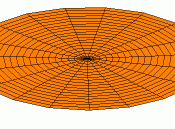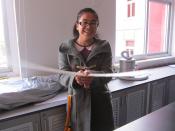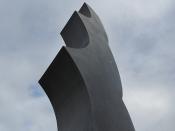Standing waves in a string: the speed with which the wave travels does not depend on the vibration that causes the wave, but on the properties of medium. In the case of string, the speed depends on the tension of the string and the mass per unit length. The vibration does affect the wavelength of the wave.
Let us consider a length of string attached at one end to a vibrating object and at the other end to a fixed point a distance L away.
We will assume that point A is vibrating with an amplitude small enough so that A can be considered a fixed point, and that a wave reflected at B will not have diminished amplitude.
A crest caused by a vibration at A will travel along the string be reflected from point B as a trough and then be reflected from point A as a crest.
If the reflection is to constructively interfere with the next wave produced, it should be reflected with the next wave produced, it should be reflected at A at the same the as the next cycle of the vibration produces the next wave. It must travel a distance of 2L in an amount of time equal to the period of the vibration T. Thus in order for a standing wave to be produced, V=2L/T since v=ûf and t=1/f L=û/2
Other higher frequencies will cause smaller standing waves for a given string with a given tension. In general, L=Nû/2 N=1, 2, 3, ...
We cab think of N as telling us the number of loops produced in the standing wave.
Standing waves in column: It turns out that standing sound waves in an air column depends on whether the column is closed or not at the ends. We should remember the fact:...


